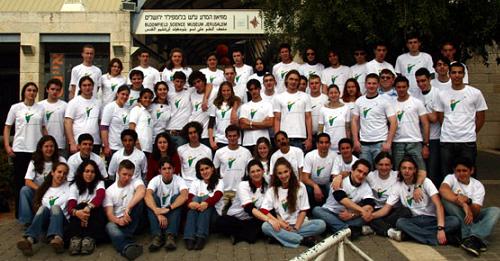Raphael Ozan, a young man from Jerusalem, won the 2006 Young Scientists Competition, which was held under the auspices of Intel and in cooperation with the Ministry of Education

Participants of the young scientists competition
In the 2006 Young Scientists Competition held under the auspices of the Intel company and in cooperation with the Ministry of Education, at the Science Museum in Jerusalem, Rafael Ozan, a graduate of Kiryat Noer High School in Jerusalem, won first place for his work - a motion detection, tracking and three-dimensional location calculation system for a burglar. Uzan immigrated to Israel from France three years ago, graduated with honors and began his military service. The prizes were awarded to the winners by the President of the State, Moshe Katsav, in a ceremony held at the Mishkan of the Presidents of Israel. This is the ninth year in a row for the existence of the competition.
According to the judges in the competition, "Ozan's project is a real advance in the field of computer vision and enables many applications such as: more autonomous robots, automatically aiming weapons, tracking and documenting the movement of a target on the battlefield, and more." This work is a breakthrough in trying to deal with the challenges facing innovative security systems. The smart system he designed and built guides a video and detects a burglar in motion and follows him in real time, consists of two parallel web cameras located at the distance of human eyes (about 7 cm). In addition, a robot is precisely aimed in coordination with the cameras, indicates a laser that points to the suspicious body and tracks its movements."
In second place came two research works done by young female scientists, students of the High School for Sciences and Arts, Jerusalem: Esther Postilnik, who studied perceptual illusions as a tool for schizophrenia; and Naama Lemberg, whose research work tested the receptivity of ovarian implants in a living body. Four research works came in third place: the joint work of two Jerusalemites - Broria Mondri, a student at the Hebrew Gymnasium, and Yonatan Gotel, from Hartman High School, who tested a new drug for type 2 diabetes; The research work of Matan Peled, from the Aleh Science School in Lod, who built software that completes sentences using a learning algorithm, to optimize the process of typing documents; Shifaa Mahmid, a student at Makif Umm Al Faham, who traced the determination of the age of the water in the aquifer (for her research an important use of the dating method and determining the age of the water and the end of the flow to obtain a good measure of the amount of water that can be used); Doron Levin, a comprehensive student of AMIT in Be'er Sheva, who investigated what is behind the Poisson problem.
About 61 teenagers participated in the competition. 40 works reached the final stage this year. Rafael Ozan, who qualified for first place, won a scholarship from the Intel company, which sponsors competitions for young scientists all over the world. Eight winning young scientists will travel this year to the Intel ISAF competitions, held in the USA.
Yitzhak (Kiki) Ohion, CEO of Intel Jerusalem and a member of the judging team: "In order for the high-tech industry in Israel to continue to flourish, we must encourage the youth to choose the professions of science and technology. The Young Scientists Competition is an important enterprise that contributes to encouraging excellence in science and technology and I am sure that the contestants will go further. In a world of global competition, we must put emphasis on the quality and proper quantity of technological science graduates in Israel in order to maintain global leadership."
The science - science projects for youth
https://www.hayadan.org.il/BuildaGate4/general2/data_card.php?Cat=~~~433181879~~~226&SiteName=hayadan

One response
are you waking up now?